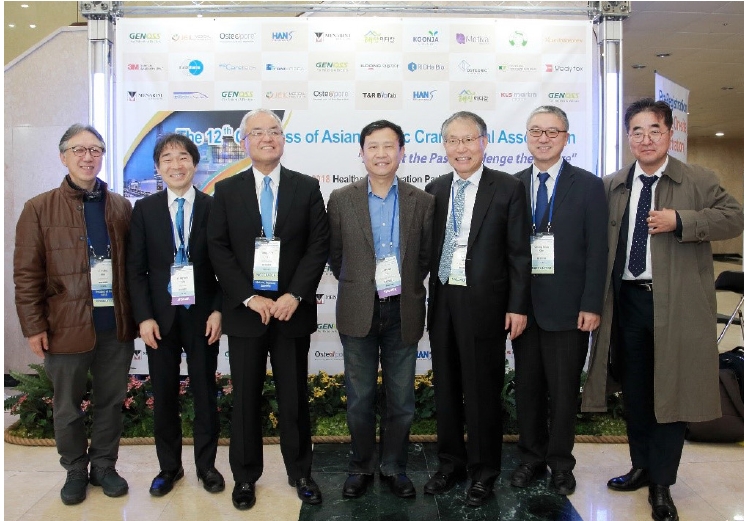 |
 |
- Search
| Arch Craniofac Surg > Volume 23(1); 2022 > Article |
|
I would like to express my congratulations on the designation of Archives of Craniofacial Surgery (ACFS) as the official journal of Asian Pacific Craniofacial Association (APCA). I still remember the cold December weather during which the 12th Congress of APCA was held successfully at Seoul National University Bundang Hospital, Korea in 2018. As the then-president of APCA I am still very grateful for the active participation of the members of APCA and Korean Cleft Palate-Craniofacial Association (KCPCA). Unfortunately, our association has not been able to convene since then due to the coronavirus disease 2019 (COVID-19) pandemic. APCA needs a space for its members to share their scientific activities with each other and ACFS can serve as an excellent platform for the members of APCA to engage in such activities. I suggested this to Prof. Kwang Seog Kim, the editor-in-chief of ACFS, who shared my view, and he proposed it to the president of APCA, Prof. LunJou Lo (Fig. 1). The proposal was discussed during the following APCA council meeting in August 19, 2021 and the council members unanimously agreed upon, laying the ground for the new cooperation between ACFS and APCA.
These circumstances remind me of the publication of the first issue of Journal of the Korean Cleft Palate-Craniofacial Association (JKCPCA) in 2000. In 1993, Korean craniofacial surgeons established a study group for facial anomaly under the leadership of Prof. Beyoung Yoon Park in Seoul, Korea, which was the foundation KCPCA developed from [1]. Prof. Chul Gyoo Park, president of KCPCA at that time, felt the need for establishing a scientific journal for KCPCA and asked me to organize it. I did so by inviting scholars of our society to build an editorial committee. The first issue containing 19 articles was successfully published in October 2000. Dr. Heung Sik Park, who now works in Shanghai, China, designed the logo of the association. The heading of the journal in Chinese characters was provided by a famous calligrapher from Gwangju, Korea, whose name I cannot provide, because I failed to record it. ACFS succeeded JKCPCA in 2012. In 2014, the publication language was changed from Korean to English to reach a broader readership [2]. Since then the journal has grown substantially in every aspect and it has the potential to grow from a regional journal published in Korean to a journal with a worldwide audience.
APCA was founded in 1994 by 20 surgeons from seven countries as a professional society representing craniofacial surgeons in the Asian-Pacific region including Oceania, under the leadership of Prof. David J. David from Australia. The purposes of APCA are listed as follows: (1) to furnish leadership and foster advances in craniofacial surgery, especially in the Asian-Pacific region; (2) to afford a forum for the exchange of knowledge pertaining to the practice of the above; (3) to stimulate research, investigation and teaching in the methods of preventing and correcting congenital and acquired craniofacial deformities; (4) to enhance the study and practice of craniofacial surgery; (5) to afford recognition to those who have contributed to craniofacial surgery by extending to them membership of the Society; (6) to develop links with similar craniofacial societies both regionally and internationally; (7) the association will not be involved in the politics of any country.
The scope of craniofacial surgery involves craniofacial trauma, including soft tissue injuries and facial bone fractures, congenital deformities such as cleft lip and palate, craniofacial microsomia, hemifacial atrophy, Pierre Robin sequence, Treacher Collins syndrome, orbital hypertelorism, nonsyndromic/syndromic craniosynostosis, congenital melanocytic nevus, vascular anomalies, conjoined twins, and head and neck reconstruction, which comprises the following domains: surgical treatment of migraine headache; scalp and forehead reconstruction; aesthetic nasal reconstruction; auricular construction; treatment of acquired cranial and facial bone deformities; orthognathic surgery; midface reconstruction; reconstruction of oral cavity, tongue, mandible, and lip; treatment of facial palsy; pharyngeal and esophageal reconstruction; and facial transplantation.
In recent years, technologies such as genomics, three-dimensional printing, biomaterials, and virtual surgical planning have been applied in the field of craniofacial surgery. These advances have facilitated diagnosis, expanded the opportunities for craniofacial surgeons to receive training in surgical skills, and dramatically improved the accuracy of craniofacial surgery.
As of 2022, ACFS is the official journal of the APCA. This will be the launching pad for its globalization. I would like to request the active participation of all craniofacial surgeons of the APCA in publishing articles in ACFS to share their scientific activities amidst the COVID-19 pandemic.
Fig.┬Ā1.
Members of the organizing committee of the 12th Congress of Asian Pacific Craniofacial Association at Seoul National University Bundang Hospital, Korea in 2018, including Prof. Kwang Seog Kim, editor-in-chief, Archives of Craniofacial Surgery and Prof. LunJou Lo, President of Asian Pacific Craniofacial Association.

- TOOLS
-
METRICS

-
- 0 Crossref
- Scopus
- 2,610 View
- 73 Download
- Related articles in ACFS
-
Dear members of the Korean Cleft Palate- Craniofacial Association2018 December;19(4)






